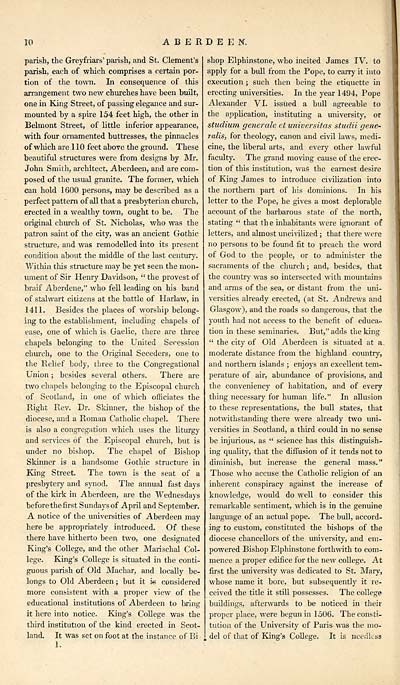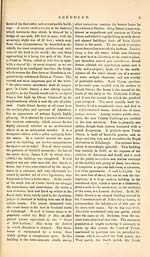Gazetteer of Scotland > Volume 1
(38) Page 10
Download files
Complete book:
Individual page:
Thumbnail gallery: Grid view | List view

10
ABERDEEN.
parish, the Greyfriars' parish, and St. Clement's
parish, each of which comprises a certain por-
tion of the town. In consequence of this
arrangement two new churches have been built,
one in King Street, of passing elegance and sur-
mounted by a spire 154 feet high, the other in
Belmont Street, of little inferior appearance,
with four ornamented buttresses, the pinnacles
of which are 1 10 feet above the ground. These
beautiful structures were from designs by Mr.
John Smith, architect, Aberdeen, and are com-
posed of the usual granite. The former, which
can hold 1600 persons, may be described as a
perfect pattern of all that a presbyterian church,
erected in a wealthy town, ought to be. The
original church of St. Nicholas, who was the
patron saint of the city, was an ancient Gothic
structure, and was remodelled into its present
condition about the middle of the last century.
Within this structure may be yet seen the mon-
ument of Sir Henry Davidson, " the provest of
braif Aberdene," who fell leading on his band
of stalwart citizens at the battle of Harlaw, in
1411. Besides the places of worship belong-
ing to the establishment, including chapels of
ease, one of which is Gaelic, there are three
chapels belonging to the United Secession
church, one to the Original Seceders, one to
the Relief body, three to the Congregational
Union ; besides several others. There are
two chapels belonging to the Episcopal church
of Scotland, in one of which officiates the
Right Rev. Dr. Skinner, the bishop of the
diocese, and a Roman Catholic chapel. There
is also a congregation which uses the liturgy
and services of the Episcopal church, but is
under no bishop. The chapel of Bishop
Skinner is a handsome Gothic structure in
King Street. The town is the seat of a
presbytery and synod. The annual fast days
of the kirk in Aberdeen, are the Wednesdays
before the first Sundays of April and September.
A notice of the universities of Aberdeen may
here be appropriately introduced. Of these
there have hitherto been two, one designated
King's College, and the other Marischal Col-
lege. King's College is situated in the conti-
guous parish of Old Machar, and locally be-
longs to Old Aberdeen ; but it i« considered
more consistent with a proper view of the
educational institutions of Aberdeen to bring
it here into notice. King's College was the
third institution of the kind erected in Scot-
land. It was set on foot at the instance of Bi
1.
shop Elphinstone, who incited James IV. to
apply for a bull from the Pope, to carry it into
execution ; such then being the etiquette in
erecting universities. In the year 1494, Pope
Alexander VI. issued a bull agreeable to
the application, instituting a university, or
studium generate et universitas studii gene-
ralis, for theology, canon and civil laws, medi-
cine, the liberal arts, and every other lawful
faculty. The grand moving cause of the erec-
tion of this institution, was the earnest desire
of King James to introduce civilization into
the northern part of his dominions. In his
letter to the Pope, he gives a most deplorable
account of the barbarous state of the north,
stating " that th e inhabitants were ignorant of
letters, and almost uncivilized ; that there were
no persons to be found fit to preach the word
of God to the people, or to administer the
sacraments of the church ; and, besides, that
the country was so intersected with mountains
and arms of the sea, or distant from the uni-
versities already erected, (at St. Andrews and
Glasgow), and the roads so dangerous, that the
youth had not access to the benefit of educa-
tion in these seminaries. But," adds the king
" the city of Old Aberdeen is situated at a.
moderate distance from the highland country,
and northern islands ; enjoys an excellent tem-
perature of air, abundance of provisions, and
the conveniency of habitation, and of every
thing necessary for human life." In allusion
to these representations, the bull states, that
notwithstanding there were already two uni-
versities in Scotland, a third could in no sense
be injurious, as " science has this distinguish-
ing quality, that the diffusion of it tends not to
diminish, but increase the general mass."
Those who accuse the Catholic religion of an
inherent conspiracy against the increase of
knowledge, would do well to consider this
remarkable sentiment, which is in the genuine
language of an actual pope. The bull, accord-
ing to custom, constituted the bishops of the
diocese chancellors of the university, and em-
powered Bishop Elphinstone forthwith to com-
mence a proper edifice for the new college. At
first the university was dedicated to St. Mary,
whose name it bore, but subsequently it re-
ceived the title it still possesses. The college
buildings, afterwards to be noticed in their
proper place, were begun in 1506. The consti-
tution of the University of Paris was the mo-
, del of that of King's College. It is needless
ABERDEEN.
parish, the Greyfriars' parish, and St. Clement's
parish, each of which comprises a certain por-
tion of the town. In consequence of this
arrangement two new churches have been built,
one in King Street, of passing elegance and sur-
mounted by a spire 154 feet high, the other in
Belmont Street, of little inferior appearance,
with four ornamented buttresses, the pinnacles
of which are 1 10 feet above the ground. These
beautiful structures were from designs by Mr.
John Smith, architect, Aberdeen, and are com-
posed of the usual granite. The former, which
can hold 1600 persons, may be described as a
perfect pattern of all that a presbyterian church,
erected in a wealthy town, ought to be. The
original church of St. Nicholas, who was the
patron saint of the city, was an ancient Gothic
structure, and was remodelled into its present
condition about the middle of the last century.
Within this structure may be yet seen the mon-
ument of Sir Henry Davidson, " the provest of
braif Aberdene," who fell leading on his band
of stalwart citizens at the battle of Harlaw, in
1411. Besides the places of worship belong-
ing to the establishment, including chapels of
ease, one of which is Gaelic, there are three
chapels belonging to the United Secession
church, one to the Original Seceders, one to
the Relief body, three to the Congregational
Union ; besides several others. There are
two chapels belonging to the Episcopal church
of Scotland, in one of which officiates the
Right Rev. Dr. Skinner, the bishop of the
diocese, and a Roman Catholic chapel. There
is also a congregation which uses the liturgy
and services of the Episcopal church, but is
under no bishop. The chapel of Bishop
Skinner is a handsome Gothic structure in
King Street. The town is the seat of a
presbytery and synod. The annual fast days
of the kirk in Aberdeen, are the Wednesdays
before the first Sundays of April and September.
A notice of the universities of Aberdeen may
here be appropriately introduced. Of these
there have hitherto been two, one designated
King's College, and the other Marischal Col-
lege. King's College is situated in the conti-
guous parish of Old Machar, and locally be-
longs to Old Aberdeen ; but it i« considered
more consistent with a proper view of the
educational institutions of Aberdeen to bring
it here into notice. King's College was the
third institution of the kind erected in Scot-
land. It was set on foot at the instance of Bi
1.
shop Elphinstone, who incited James IV. to
apply for a bull from the Pope, to carry it into
execution ; such then being the etiquette in
erecting universities. In the year 1494, Pope
Alexander VI. issued a bull agreeable to
the application, instituting a university, or
studium generate et universitas studii gene-
ralis, for theology, canon and civil laws, medi-
cine, the liberal arts, and every other lawful
faculty. The grand moving cause of the erec-
tion of this institution, was the earnest desire
of King James to introduce civilization into
the northern part of his dominions. In his
letter to the Pope, he gives a most deplorable
account of the barbarous state of the north,
stating " that th e inhabitants were ignorant of
letters, and almost uncivilized ; that there were
no persons to be found fit to preach the word
of God to the people, or to administer the
sacraments of the church ; and, besides, that
the country was so intersected with mountains
and arms of the sea, or distant from the uni-
versities already erected, (at St. Andrews and
Glasgow), and the roads so dangerous, that the
youth had not access to the benefit of educa-
tion in these seminaries. But," adds the king
" the city of Old Aberdeen is situated at a.
moderate distance from the highland country,
and northern islands ; enjoys an excellent tem-
perature of air, abundance of provisions, and
the conveniency of habitation, and of every
thing necessary for human life." In allusion
to these representations, the bull states, that
notwithstanding there were already two uni-
versities in Scotland, a third could in no sense
be injurious, as " science has this distinguish-
ing quality, that the diffusion of it tends not to
diminish, but increase the general mass."
Those who accuse the Catholic religion of an
inherent conspiracy against the increase of
knowledge, would do well to consider this
remarkable sentiment, which is in the genuine
language of an actual pope. The bull, accord-
ing to custom, constituted the bishops of the
diocese chancellors of the university, and em-
powered Bishop Elphinstone forthwith to com-
mence a proper edifice for the new college. At
first the university was dedicated to St. Mary,
whose name it bore, but subsequently it re-
ceived the title it still possesses. The college
buildings, afterwards to be noticed in their
proper place, were begun in 1506. The consti-
tution of the University of Paris was the mo-
, del of that of King's College. It is needless
Set display mode to: Large image | Transcription
Images and transcriptions on this page, including medium image downloads, may be used under the Creative Commons Attribution 4.0 International Licence unless otherwise stated. ![]()
| Gazetteers of Scotland, 1803-1901 > Gazetteer of Scotland > Volume 1 > (38) Page 10 |
|---|
| Permanent URL | https://digital.nls.uk/97424818 |
|---|
| Description | Volume I: Abbey to Glenartney. |
|---|---|
| Attribution and copyright: |
|
| Description | By Robert Chambers and William Chambers. Glasgow: Blackie & Son, 1838. 2 volumes. |
|---|---|
| Shelfmark | NF.1461.g.7 |
| Additional NLS resources: | |

